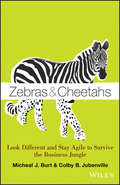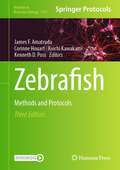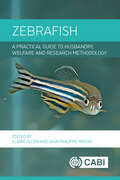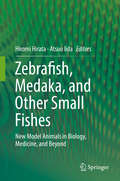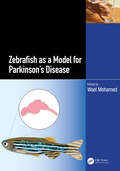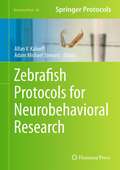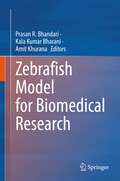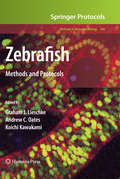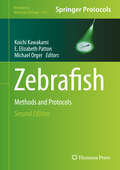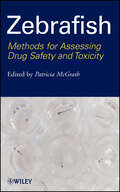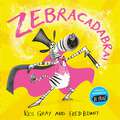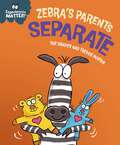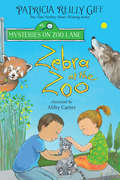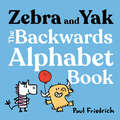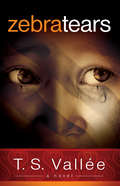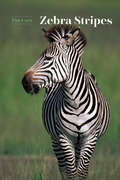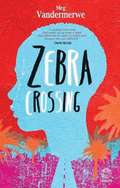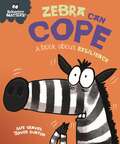- Table View
- List View
Zebras and Cheetahs: Look Different and Stay Agile to Survive the Business Jungle
by Colby B. Jubenville Micheal J. BurtPraise for Zebras and Cheetahs"It's not the big that eat the small. Today, it's the fast that eat the slow. Zebras and Cheetahs teaches you step by step how to run faster, to be agile in the business jungle, and to pounce on opportunity 10x quicker than your competitors."-GRANT CARDONE, New York Times bestselling author of Sell or Be Sold"Business is a game for everyone, and whether you're an entrepreneur, a small business owner, or a corporate executive, you need a guide. If you're striving for growth and profound leadership, the Zebra and Cheetah philosophy will not only guide you through the jungle alive, it will position you to be King."-JEFFREY HAYZLETT, global business celebrity, bestselling author, and sometime cowboy"A fresh and unique look at leaders-and how to become a better one."-RANDY GAGE, New York Times bestselling author of Risky Is the New Safe"Standing out by being decidedly different, agile, and resilient are three themes of utmost importance for business success today. This book will give you insights, strategies, and tactics for achieving all three-and much more."-MARK SANBORN, author of The Fred Factor and Fred 2.0"Growing a business is not easy or for the faint of heart. In Zebras and Cheetahs, Micheal and Colby offer a refreshing and entertaining take on how to see what you do differently, grow your leadership capabilities in new ways, and execute a growth plan."-Doug Tatum, author of No Man's Land: Where Growing Companies Fail; Associate Professor of Entrepreneurship, MTSU Wright Travel Chair
Zebras (Black And White Animals Ser.)
by Mari SchuhLook inside this fun picture book to learn all about Zebras!
Zebrafish: Methods and Protocols (Methods in Molecular Biology #2707)
by Koichi Kawakami James F. Amatruda Kenneth D. Poss Corinne HouartThis fully updated edition introduces new tools, models, and analytic insights that position the zebrafish even more strongly as an engine of discovery for developmental and disease biology. Beginning with a section exploring detailed methods for use of zebrafish to model a variety of human diseases, the book continues by illuminating the key ongoing role of the fish model in studies of the vertebrate nervous system, tools and approaches using zebrafish to study stem cell and regenerative biology, as well as techniques in genetics and genomics. Written for the highly successful Methods in Molecular Biology series, chapters include introductions to their respective topics, lists of the necessary materials and reagents, step-by-step and readily reproducible laboratory protocols, as well as tips on troubleshooting and avoiding known pitfalls. Authoritative and up-to-date, Zebrafish: Methods and Protocols, Third Edition serves as an invaluable guide to propel advances in developmental biology, disease modeling, and regeneration research using zebrafish and medaka as model systems.
Zebrafish: A Practical Guide to Husbandry, Welfare and Research Methodology
by Rita Almeida Amy Spencer Christian Lawrence Kamar E. Ameen-Ali James Bull Carolina Cabrera Joanna Cambray-Young Ana Catarina Certal Karishma Chhabria Pam S. Ellis Catarina M. Henriques Sara Hilditch Michael L. Kent Peter Laud Raquel R. Martins Sandra Martins Mollie E. Millington Joana Monteiro Katrina N. Murray Paul G. Schroeder Lynne U. Sneddon Eleanor StillmanAfter securing popularity in home aquariums, zebrafish have also become an essential animal for biomedical research. Ensuring they are adequately cared for in research settings is therefore of the utmost importance and this book is designed to help laboratories develop good welfare and husbandry practices, refine procedural protocols and engage with ethical obligations. A wide range of topics are addressed, starting with husbandry aspects such as environmental enrichment, nutrition, housing conditions, diseases, health monitoring, biosecurity and larval rearing. More experimental topics are then discussed, such as genotyping, ageing, imaging, behavioural studies, experimental design and statistics. Ethical challenges are also considered through the environmental impact of aquatic facilities and the 3Rs - Replacement, Reduction and Refinement - with a focus on anaesthesia, analgesia, euthanasia and severity assessment. Zebrafish are a shoaling species by nature but this book also takes into account their individual needs by providing: - practical advice from experienced zebrafish caretakers; - bridges between data acquisition and fish welfare; and - the latest guidance for reporting, reproducibility and compliance. This book is written for zebrafish facility personnel and for researchers who are aware of the need for robust care for their zebrafish model. It also provides an unparalleled insight for ethics committee members with the intention to provide the best care possible for this ever-important fish.
Zebrafish: A Model for Marine Peptide Based Drug Screening
by Senthilkumar Rajagopal Saravanan RamachandranThis book offers a comprehensive overview of toxicology, highlighting the significance of peptide-based toxins from marine environments. It discusses the principles of protein-carbohydrate and domain-domain interactions to increase our understanding of toxicology in zebrafish models, as well as drug interaction mechanisms and target definition in drug discovery. It also reviews the structure of marine peptides/toxins and the toxicology of peptide secreting cells and cells that respond to these enzymes, and describes the normal and abnormal toxicology of marine peptides in zebrafish models. Offering insights into the field of proteomics, particularly current practice and research models for solving its many riddles, the book also explains the analytical principles of marine protein-protein and protein-carbohydrate interaction in the context of teratogenicity in target identification in peptide- based drug discovery. Lastly, the book methodically examines the preclinical research on marine proteins/peptides.
Zebrafish, Medaka, and Other Small Fishes: New Model Animals In Biology, Medicine, And Beyond
by Hiromi Hirata Atsuo IidaThis book provides cutting-edge studies and technologies using small fishes, including zebrafish, medaka, and other fishes as new model animals for molecular biology, developmental biology, and medicine. It also introduces eccentric fish models that are pioneering new frontiers of biology.Zebrafish and medaka have been developed as lower vertebrate model organisms because these small fish are easy to raise in the laboratory and are useful for the live imaging of the morphology and activity of cells and tissues in intact animals. By virtue of those specific advantages, fish studies have demonstrated the common features of vertebrates and raised further questions toward understanding the mystery of life.The book consists of four parts: “Development and Cell Biology”, “Homeostasis and Reproduction”, “Clinical Models”, and “Eccentric Fish”. Together they describes the core area of small fish study – often considered mere zoology but which is actually proving to be the universal basis of life.Written by leading scientists, the book helps readers to understand small fishes, inspires scientists to utilize small fishes in their studies, and encourages anyone who wants to participate in the large and fantastic world of small fish.
Zebrafish as a Model for Parkinson’s Disease
by Wael MohamedThe increasing demand for innovative techniques arises from the lack of safe, effective, and patient-friendly therapies for neurodegenerative disorders. With this objective in mind, the chapters of the book are structured to offer a thorough insight into recent advancements in utilizing the zebrafish (ZF) as a model for studying Parkinson’s disease (PD). This book aims to present readers with a comprehensive understanding of the clinical application of the ZF model in treating PD, encompassing the latest developments, challenges, safety considerations, toxicity issues, regulatory aspects, future potential, and limitations. Individuals in academia, the scientific community, business, and education seeking a more effective approach to target the brain stand to benefit from this resource.Key Features Provides a comparative perspective of the zebrafish–Parkinson’s disease model Highlights the restrictions of available medicines Describes biochemical and histopathological characteristics, advantages, and disadvantages of this model Emphasizes distinct facets of histopathology Presents advances and developments of the future potential perspectives
Zebrafish Protocols for Neurobehavioral Research
by Allan V. Kalueff Adam Michael StewartZebrafish (Danio rerio) play an integral role in biomedical research, enabling researchers to examine physiological mechanisms and pathways relevant to human pathogenesis and its therapy. That, along with their low cost, easy manipulation, short reproductive cycles, and physiological homology to humans, has made zebrafish a vital model organism for neuroscience research. Zebrafish Protocols for Neurobehavioral Research addresses protocols for both larval and adult models, written by the leading experts in the field of zebrafish research. Part I of this book takes advantage of the high-throughput nature of larval models to offer protocols for research requiring high output, easily manipulated screens. The second half of the book focuses on the robust and sophisticated behaviors of adult zebrafish, suitable for the neurophenotyping of complex traits and multi-domain disorders. Importantly, these models complement each other, working together to provide researchers with valuable insights into neurobiology of normal and pathological behavior. Thorough and cutting-edge, this volume is a useful, authoritative reference guide that should hold a coveted spot in zebrafish laboratories across the globe.
Zebrafish Neurobehavioral Protocols
by Allan V. Kalueff Jonathan M. CachatAs a model organism, zebrafish (Danio rerio) offer an opportunity to perform steadfast scientific investigations in a robust and high-throughput manner. In Zebrafish Neurobehavioral Protocols, experts in the field provide a series of detailed behavioral protocols dealing with the major current research areas in the field of behavioral neuroscience. The chapters discuss the use and interpretation of video-aided quantification of zebrafish behaviors, describe novel assays commonly used to quantify emotionality, learning, memory, and social behaviors in zebrafish, and instruct how to quantify endocrine responses and correlate them with behavior. Written in the Neuromethods series format, the chapters provide authoritative reviews of many commonly used approaches in the field today. This "how to" book will be a useful practical guide for zebrafish researchers and will complement another related book from this series, Zebrafish Models in Neurobehavioral Research. Cutting-edge and timely, Zebrafish Neurobehavioral Protocols serves as an excellent compilation epitomizing the growing potential of zebrafish in modern scientific inquiry.
Zebrafish Models of Neurodegenerative Disorders (Neuroscience of Neurodegenerative Disease)
by Ebru Emekli-AlturfanAdvancing our understanding of neurodegenerative diseases demands innovative tools and approaches. Zebrafish Models in Neurodegenerative Disorders offers a comprehensive examination of zebrafish as a translational model for studying the molecular and cellular mechanisms of diseases such as Alzheimer’s, Parkinson’s, and Huntington’s diseases. Beginning with the first section informing about the basic molecular mechanisms of neurodegenerative disorders, biomarkers, and therapeutic approaches, the book continues with the detailed exploration of zebrafish physiology, genetics, and behavioural phenotypes as they pertain to neurodegenerative pathologies; insight into cutting-edge technologies, including CRISPR/Cas9 genome editing; and in-depth analysis of zebrafish models, highlighting their strengths in modelling disease progression and therapeutic testing.
Zebrafish Models in Neurobehavioral Research
by Allan V. Kalueff Jonathan M. CachatAnimal models have traditionally played a crucial role in improving our understanding of brain pathogenesis. Zebrafish (Danio rerio) have generated considerable discoveries in the areas of genetics, embryology, endocrinology, and neuroscience. Zebrafish Models in Neurobehavioral Research emphasizes the growing importance of zebrafish in neurobehavioral research and portrays an extensive, thorough perspective on the emergence of zebrafish as robust and translational models. Written by leading international experts, the book covers major topics ranging from stress to learned recognition of environment, encompassing a wide spectrum of the utility of zebrafish within neurobiological disciplines. The chapters provide authoritative reviews of many zebrafish paradigms commonly used in the field today. This book will be a useful guide for zebrafish researchers, and will complement another related book from the popular Neuromethods series, Zebrafish Neurobehavioral Protocols. Comprehensive and up-to-date, Zebrafish Models in Neurobehavioral Research serves as an ideal resource for scientists new to the field as well as for established researchers seeking valuable insight into the growing utility of zebrafish in neuroscience.
Zebrafish Model for Biomedical Research
by Prasan R. Bhandari Kala Kumar Bharani Amit KhuranaThis book provides the latest information on the significance of zebrafish as an ideal model for researching the biomedical field, with references. This book also focused on the evidence of zebrafish as a model in cardiovascular, neurologic, psychiatric and metabolic research. In addition, the book also includes the research carried out on zebrafish in hepatic, renal, ophthalmic, and ENT related areas. Contributed chapters come from the most prominent laboratories working in this field, which provides a unique perspective on zebrafish models from a wide spectrum of the research community. In addition, the book offers a detailed analysis of the most current research in the area for specific zebrafish models including specific research in the area of skin disorders, endocrine diseases, nutritional disorders, gastrointestinal, hematological disorders and cancer. The compilation of chapters in the volume culminates into a comprehensive and definitive text on zebrafish and its suitability for modeling various diseases, providing a critical resource on the potential attributes of the zebrafish as a pharmacological model. In terms of scope, this book is a useful tool for young researchers, professors and pharmaceutical scientists for understanding the significance of zebrafish as an emerging pharmacological model that can significantly aid in the process of drug discovery and development.
Zebrafish
by Koichi Kawakami Graham J. Lieschke Andrew C. OatesIn the last 20 years, research activity using the zebrafish Danio rerio has increased dramatically, due in part to the ease of breeding and raising them, their genetic tractability, embryonic accessibility, and their imaging potential. In Zebrafish: Methods and Protocols, expert researchers provide a collection of experimental techniques for the genetic modification, manipulation, and in vivo live imaging of zebrafish. This volume collects sophisticated and practical techniques, including several not yet widely known, from laboratories around the world. Written in the highly successful Methods in Molecular BiologyTM series format, chapters include brief introductions to their respective topics, lists of the necessary materials and reagents, step-by-step, readily reproducible laboratory protocols, and notes on troubleshooting and avoiding known pitfalls. Authoritative and accessible, Zebrafish: Methods and Protocols seeks to aid and inspire scientists utilizing this versatile animal model in their research.
Zebrafish
by Koichi Kawakami E. Elizabeth Patton Michael OrgerThissecond edition details new emerging areas of zebrafish research focusing on geneticsand genomics, techniques for developing and analyzing zebrafish disease models,and methods for neuroscience. Zebrafish:Methods and Protocols, Second Edition guides readers through methods for mutagenesisand genome editing in zebrafish, applicationsof GFP-expressing transgenic fish, techniques for cancer models, imaging of infectionand host-pathogen interactions, metabolism and transport of lipids, and the structure and function of neural circuitsand their role in generating behavior. Written in the highlysuccessful Methods in Molecular Biology series format, chapters includeintroductions to their respective topics, lists of the necessary materials andreagents, step-by-step, readily reproducible laboratory protocols, and tips ontroubleshooting and avoiding known pitfalls. Authoritative and practical Zebrafish: Methods and Protocols, Second Edition is a usefulcomplement to the first book for new and experienced zebrafish researcheralike.
Zebrafish
by Patricia McgrathZebrafish: Methods for Assessing Drug Safety and Toxicity offers a practical guide for using zebrafish as a tool for toxicology studies. Consolidating key protocols and approaches to help researchers navigate the important and evolving field of zebrafish models for toxicity screening, this new title describes the methods for using the zebrafish as a model organism to assess compound-induced toxicity on all major organs. Individual chapters that concentrate on assays for each organ system are included and various analytical tools including microscopy, microplate readers, high content imaging systems, ECG, blood pressure monitors, high speed video and motion detectors are described.
Zebracadabra!
by Kes GrayMeet Zebracadabra, master of magic. Watch as he transforms his animal friends before your very eyes!"ZEBRACADABRA!"Pink flamingos turn into... black-and-white stripy flamingos!"ZEBRACADABRA!"A green alligator turns into... a black-and-white stripy alligator!"ZEBRACADABRA!"Colourful chameleons turn into... you guessed it - black-and-white stripy chameleons!How does Zebracadabra do it? By being the best magician in the world, of course! Or he would be, if only he knew how to turn the animals back to their original colours...A laugh-out-loud picture book from Kes Gray, author of Oi Frog, with gloriously silly illustrations by Fred Blunt.
Zebra: The True Account of the 179 Days of Terror in San Francisco
by Clark HowardEdgar Award Finalist: The true story of a string of brutal crimes committed in the name of religious fanaticism and racial hatred in 1970s San Francisco. In the early 1970s, a small band of well-dressed, clean-cut African American men began terrorizing the residents of San Francisco with guns and machetes. Their victims ranged from a teenage Salvation Army cadet to a middle-aged Jordanian grocer to an eighty-one-year-old janitor. The streets became deserted and tourism plunged. It took months before the culprits could be identified, with the help of an informer. They were members of a Black Muslim cult aspiring to earn the title &“Death Angel&” by slaughtering white victims. Combining history and dramatic recreations, this is the &“repellent but riveting&” in-depth story of a horrifying killing spree and the fanatical hatred that drove it—and the SFPD&’s desperate quest to take the culprits down (Kirkus Reviews). &“[Clark Howard&’s] pounding narrative meticulously describes the so-called Zebra killings of 1973–74, when 23 white San Franciscans were murdered or maimed by a group of Black Muslim extremists. In the retelling, the cold jargon of police files leaps starkly to life.&” —Time
Zebra's Parents Separate (Experiences Matter #137)
by Sue GravesZebra's Parents Separate offers a gentle introduction to the experience of parents separating for young children.This gentle, charming story is the perfect way to introduce young children to the experience of parental separation. Also included are suggestions for activities and ideas to talk through together to help children reflect on their own experiences.Zebra's mum and dad have decided that they want to separate. Dad is moving to a new house, and Zebra is worried. She doesn't know if she will like living in two different homes. Luckily, Mrs Bear helps her to feel better, and Zebra soon finds she likes Dad's new home too.The Experiences Matter series of picture books provide a gentle means of discussing experiences, boosting self-esteem and reinforcing good behaviour. Supports the Personal, Social and Emotional Development Area of Learning in the Early Years Foundation Stage, and is also suitable for use with children in KS1 and can be used to discuss values. Suitable for children under 5.
Zebra at the Zoo (Mysteries on Zoo Lane #3)
by Patricia Reilly GiffA broken fence and an animal on the loose take center stage in book three of the series from a two-time Newbery Honor winning author.Alex loves living on Zoo Lane, especially because he gets to visit his favorite animal in the world: the red panda. When he finds a hole in the zoo's fence, it presents the perfect opportunity to sneak into the zoo before school to see his beloved furry creatures. What Alex doesn't realize is that the broken fence will cause more problems than almost getting caught by the security guard. When an animal goes missing in the zoo, can he come clean about the fence?In this third book of the series, two-time Newbery Honor author Patricia Reilly Giff has crafted a lively mystery about conservation, animal care, friendship, and problem-solving. In touch with the programs and initiatives that today's zoos are undertaking, Giff provides readers with a fresh look at the work of zoologists. Charming line artwork by Abby Carter appears throughout and keeps the story upbeat.
Zebra and Yak: The Backwards Alphabet Book (Zebra and Yak)
by Paul FriedrichA hilarious and unexpected backward alphabet picture book.Are you ready to start the alphabet? Let's go! Z is for Zebra.Confused? Zebra didn't expect the alphabet to start with Z, either. Usually it starts with A is for Apple, B is for . . . something, then all the other letters, then Z. But today Apple was nowhere to be found.Zebra isn't very happy about it. Neither is the second-to-last animal in the alphabet, Yak.In order to figure out where their friend Apple might be, Zebra and Yak must go on a quest to discover what's gone wrong. But in an alphabet book this weird, who knows what could happen next?
Zebra Tears: A Novel
by Ms. T. S. ValléeWhile traveling to the beach with her daughter and grandchildren, Tess reminisces about her childhood playing on the grounds of an old Indian palace by the sea. Tess knows as she shares these memories that she cannot avoid telling of the pain and hurt she endured.Follow Tess as young girl growing up in India and her experiences at the St. Mary&’s Convent boarding school. The loneliness, rejection, and abuse she receives do not stop Tess from seeking the happiness, love and forgiveness she desires.
Zebra Stripes
by Tim CaroFrom eminent biologists like Alfred Russel Wallace and Charles Darwin to famous authors such as Rudyard Kipling in his Just So Stories, many people have asked, “Why do zebras have stripes?” There are many explanations, but until now hardly any have been seriously addressed or even tested. In Zebra Stripes, Tim Caro takes readers through a decade of painstaking fieldwork examining the significance of black-and-white striping and, after systematically dismissing every hypothesis for these markings with new data, he arrives at a surprising conclusion: zebra markings are nature’s defense against biting fly annoyance. Popular explanations for stripes range from camouflage to confusion of predators, social facilitation, and even temperature regulation. It is a serious challenge to test these proposals on large animals living in the wild, but using a combination of careful observations, simple field experiments, comparative information, and logic, Caro is able to weigh up the pros and cons of each idea. Eventually—driven by experiments showing that biting flies avoid landing on striped surfaces, observations that striping is most intense where biting flies are abundant, and knowledge of zebras’ susceptibility to biting flies and vulnerability to the diseases that flies carry—Caro concludes that black-and-white stripes are an adaptation to thwart biting fly attack. Not just a tale of one scientist’s quest to solve a classic mystery of biology, Zebra Stripes is also a testament to the tremendous value of longitudinal research in behavioral ecology, demonstrating how observation, experiment, and comparative research can together reshape our understanding of the natural world.
Zebra Crossing
by Meg VandermerweGhost. Ape. Living dead. Young Chipo has been called many names, but to her mother - Zimbabwe 's most loyal Manchester United supporter - she had always just been Chipo, meaning gift. On the eve of the World Cup, Chipo and her brother flee to Cape Town hoping for a better life and to share in the excitement of the greatest sporting event ever to take place in Africa. But the Mother City's infamous Long Street is a dangerous place for an illegal immigrant and albino. Soon Chipo is caught up in a get-rich-quick scheme organized by her brother and the terrifying Dr Ongani. Exploiting gamblers' superstitions about albinism, they plan to make money and get out before rumors of looming xenophobic attacks become reality. But their scheming has devastating consequences.
Zebra Can Cope - A book about resilience (Behaviour Matters)
by Sue GravesZebra Can Cope offers a gentle introduction to the concept of resilience, and keeping trying, for young children.This funny, charming story is the perfect way to introduce young children the concept of reslience, giving them tools to help them cope in everyday situations. Also included are suggestions for activities and ideas to talk through together to help children understand their behaviour.Zebra often worries about things. She worries whether she will cope if things don't go to plan. Then, when she is out on a canoeing trip, she really does need to find a way to manage her worries and work out a solution. Will she be able to cope?The Behaviour Matters series of picture books provide a gentle means of discussing emotions, boosting self-esteem and reinforcing good behaviour. Supports the Personal, Social and Emotional Development Area of Learning in the Early Years Foundation Stage, and is also suitable for use with children in KS1 and can be used to discuss values. Suitable for children under 5.
